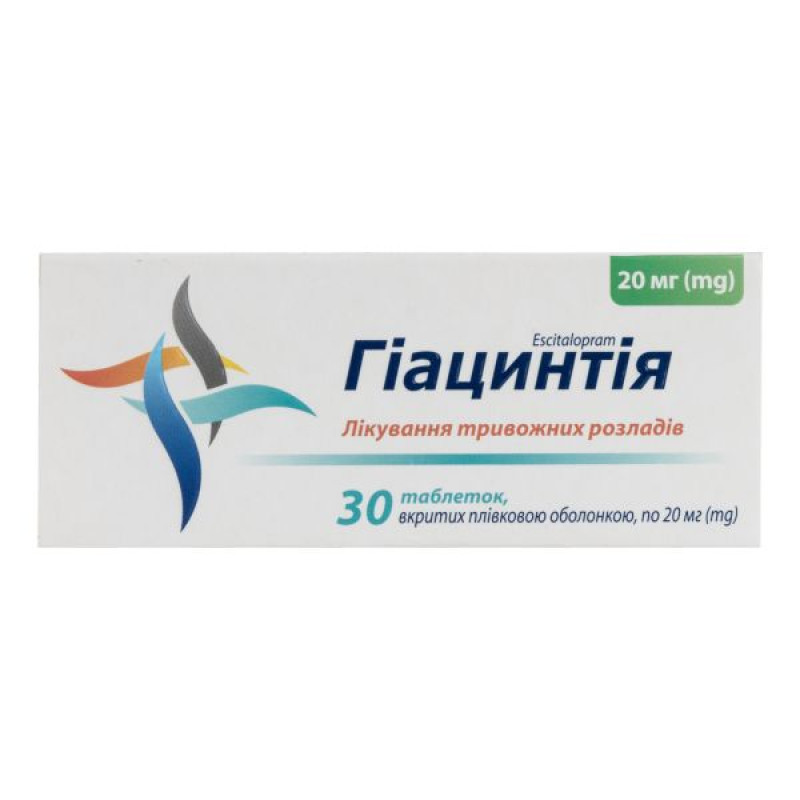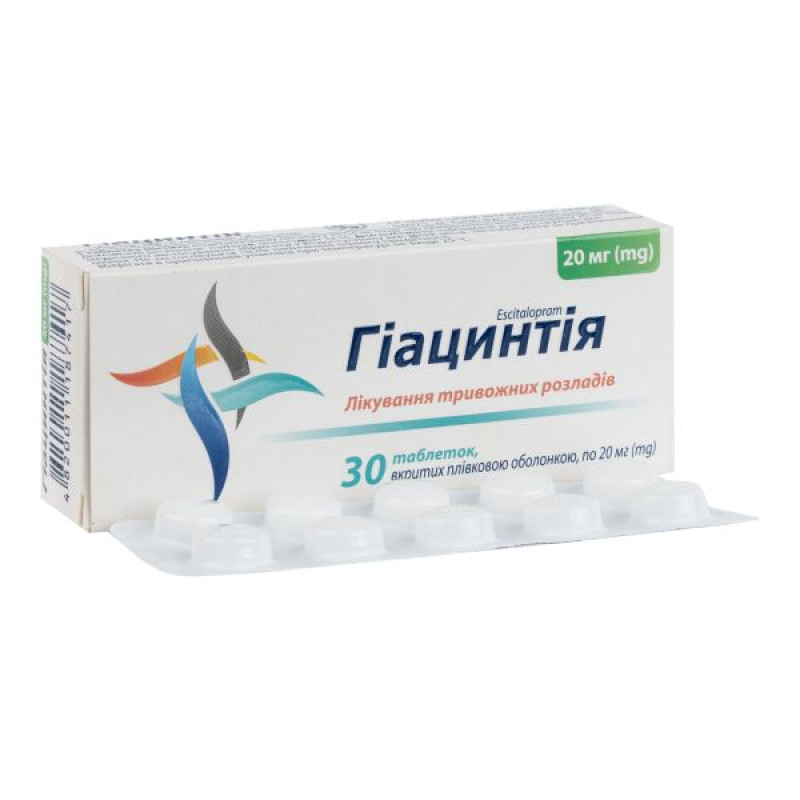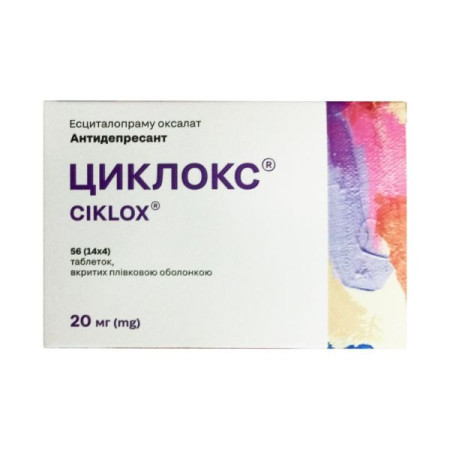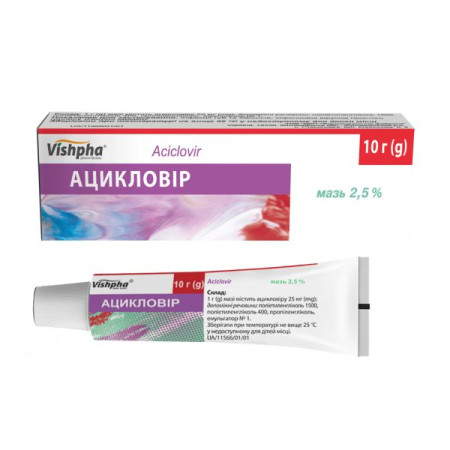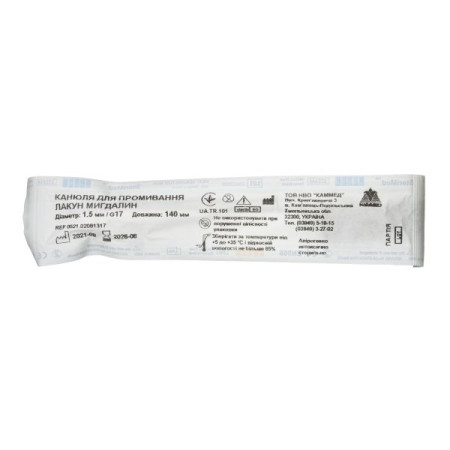Hyacinthia tablets 20mg No. 30
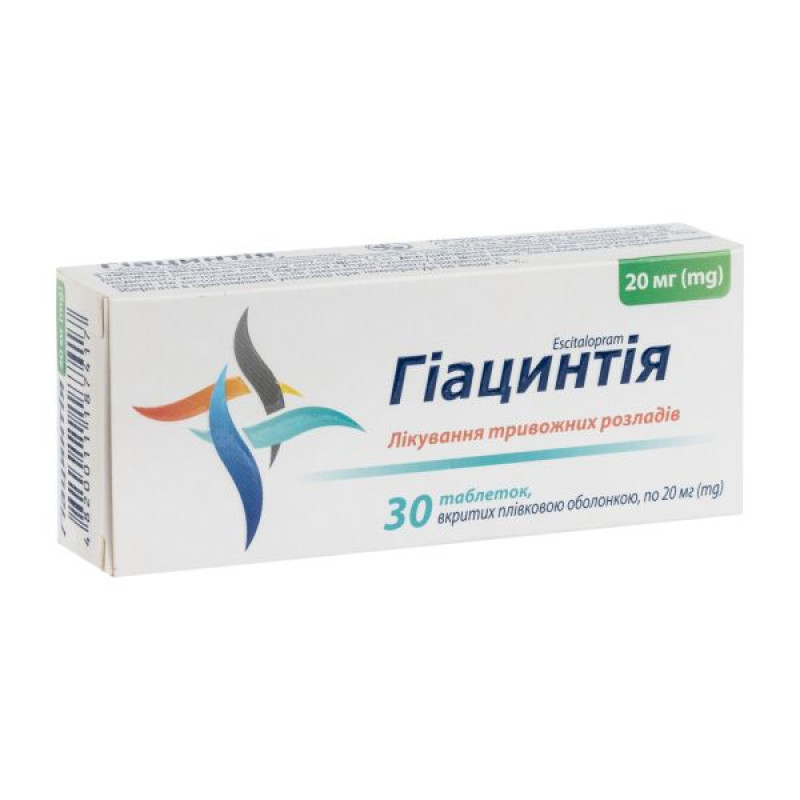
Instructions Hyacinthia tablets 20mg No. 30
Composition
active ingredient: escitalopram;
1 tablet contains 25.54 mg of escitalopram oxalate, equivalent to 20 mg of escitalopram;
excipients: silicified microcrystalline cellulose, talc, croscarmellose sodium, magnesium stearate;
shell: Opadry II White film coating mixture: hypromellose (hydroxypropylmethylcellulose); lactose monohydrate; polyethylene glycol; titanium dioxide (E 171).
Dosage form
Film-coated tablets.
Main physicochemical properties: round tablets with a biconvex surface, with a score on one side, covered with a white film coating.
Pharmacotherapeutic group
Antidepressants. Selective serotonin reuptake inhibitors (SSRIs). ATC code N06A B10.
Pharmacological properties
Pharmacodynamics
Escitalopram is an antidepressant, a selective serotonin reuptake inhibitor, which determines the clinical and pharmacological effects of the drug. It has high affinity for the main binding element and the adjacent allosteric element of the serotonin transporter and has no or very weak ability to bind to receptors, including serotonin 5-HT1A-, 5-HT2-receptors, dopamine D1- and D2-receptors, α1-, α2-, β-adrenergic receptors, histamine H1-, muscarinic cholinergic, benzodiazepine and opiate receptors.
Escitalopram is the S-enantiomer of racemic citalopram with its own therapeutic activity. The R-enantiomer has been shown to be inert and to antagonize the serotonergic properties and corresponding pharmacological effects of the S-enantiomer.
Pharmacokinetics
Absorption is almost complete and independent of food intake. Maximum plasma concentration is reached 4 hours after administration. Bioavailability of escitalopram is approximately 80%. Binding of escitalopram and its main metabolites to blood proteins is below 80%. Metabolism occurs in the liver to demethylated and didemethylated metabolites. Both of them are pharmacologically active. Biotransformation of escitalopram to the demethylated metabolite occurs with the help of cytochrome CYP2C19. Minor participation in the process of isoenzymes CYP3A4 and CYP2D6 is possible. The half-life (T½) of the drug is approximately 30 hours. Clearance (Cloral) when taken orally is approximately 0.6 l / min. The half-life is longer for the main metabolites. Escitalopram and its main metabolites are excreted through the liver (metabolic pathway) and kidneys. Most of the dose is excreted as metabolites in the urine. The kinetics of escitalopram are linear. Steady-state concentrations are reached after approximately 1 week.
In patients over 65 years of age, escitalopram is eliminated more slowly than in younger patients.
In patients with mild to moderate hepatic impairment (Child-Pugh classes A and B), the half-life was 2-fold longer and exposure was 60% higher than in subjects with normal hepatic function.
In patients with reduced renal function, a longer half-life and slightly higher exposure were observed when racemic citalopram was administered. Plasma concentrations of metabolites have not been studied but may be increased.
Patients with poor CYP2C19 metaboliser function had twice the plasma concentrations of escitalopram as patients with normal CYP2C19 function. No significant changes in exposure were observed with reduced CYP2D6 function.
Indication
Treatment of major depressive episodes, panic disorders with or without agoraphobia, social anxiety disorders (social phobia), generalized anxiety disorders, obsessive-compulsive disorders.
Contraindication
Hypersensitivity to escitalopram or to any of the other ingredients of the drug; concomitant treatment with non-selective, irreversible monoamine oxidase inhibitors (MAOIs) or pimozide; combination treatment with reversible MAO-A inhibitors (e.g. moclobemide) or the reversible non-selective MAO inhibitor linezolid, as there is a risk of serotonin syndrome; QT prolongation or congenital long QT syndrome; concomitant use with drugs that prolong the QT interval.
Interaction with other medicinal products and other types of interactions
Pharmacodynamic interactions
Contraindicated combinations
Non-selective irreversible MAOIs. There are reports of serious reactions in patients taking SSRIs in combination with a non-selective irreversible MAOI and in patients who have recently stopped taking an SSRI and started taking an MAOI. In some cases, serotonin syndrome has developed. The combination of escitalopram with non-selective irreversible MAOIs is contraindicated. Treatment with escitalopram should be initiated 14 days after discontinuation of the irreversible MAOI. Treatment with non-selective irreversible MAOIs should be initiated no earlier than 7 days after discontinuation of escitalopram.
QT prolongation. Pharmacokinetic and pharmacodynamic studies of escitalopram in combination with other drugs that prolong the QT interval have not been conducted. A cumulative effect of escitalopram and these drugs cannot be excluded. Therefore, concomitant administration of escitalopram with drugs that prolong the QT interval, such as class IA and III antiarrhythmics, neuroleptics (e.g. phenothiazine derivatives, pimozide, haloperidol), tricyclic antidepressants, certain antimicrobials (e.g. sparfloxacin, moxifloxacin, intravenous erythromycin, pentamidine, antimalarials, including halofantrine), certain antihistamines (astemizole, mizolastine), is contraindicated.
Combinations requiring caution
Reversible selective MAOI type A (moclobemide). Due to the risk of serotonin syndrome, the combination of escitalopram with the type A MAOI moclobemide is not recommended. If the need for this combination is proven, the minimum recommended doses should be prescribed initially with careful clinical monitoring.
Treatment with escitalopram can be started no earlier than 1 day after stopping the reversible MAOI moclobemide.
Reversible non-selective MAO inhibitor (linezolid). Concomitant use of escitalopram with the antibiotic linezolid is contraindicated in patients taking escitalopram. If the use of this combination is considered necessary, the minimum recommended doses should be initially prescribed under close medical supervision.
Selegiline. Combination with selegiline (an irreversible type B MAOI) requires caution due to the risk of serotonin syndrome.
Serotonergic medicinal products: Concomitant use with serotonergic medicinal products (e.g. tramadol, sumatriptan and other triptans) may lead to serotonin syndrome.
Medications that lower the seizure threshold. SSRIs may lower the seizure threshold. Caution is advised with concomitant use of medications that may lower the seizure threshold (e.g. antidepressants (tricyclics, SSRIs), neuroleptics (phenothiazines, thioxanthenes, butyrophenones), mefloquine, bupropion and tramadol).
Lithium, tryptophan. Since cases of increased effects have been reported with the simultaneous use of SSRIs and lithium or tryptophan, caution is recommended when these drugs are prescribed simultaneously.
St. John's wort. Concomitant use of SSRIs and herbal remedies containing St. John's wort may lead to an increased incidence of adverse reactions.
Anticoagulants: The effects of anticoagulants may be altered by concomitant use with escitalopram. If patients are taking oral anticoagulants, careful monitoring of the blood coagulation system is necessary before and after the use of escitalopram.
Concomitant use of nonsteroidal anti-inflammatory drugs may increase the tendency to bleed.
Alcohol: Escitalopram does not interact with alcohol in a pharmacodynamic or pharmacokinetic manner. However, the combination with alcohol is undesirable.
Medicinal products causing hypokalemia/hypomagnesemia: Caution should be exercised when concomitantly administering medicinal products causing hypokalemia/hypomagnesemia as the risk of malignant arrhythmias may be increased.
Pharmacokinetic interactions
Effect of other agents on the pharmacokinetics of escitalopram
The metabolism of escitalopram is mainly mediated by CYP2C19.
Co-administration of escitalopram and omeprazole (a CYP2C19 inhibitor) leads to a moderate (approximately 50%) increase in escitalopram plasma concentrations.
Concomitant administration of escitalopram and cimetidine (a moderately potent major enzyme inhibitor) results in a moderate (approximately 70%) increase in escitalopram plasma concentrations.
Therefore, caution should be exercised when prescribing the upper limit doses of escitalopram when escitalopram is co-administered with CYP2C19 inhibitors (e.g. omeprazole, fluoxetine, fluvoxamine, lansoprazole, ticlopidine) and with cimetidine. A dose reduction of escitalopram may be necessary based on clinical judgment.
Effect of escitalopram on the pharmacokinetics of other drugs
Escitalopram is an inhibitor of the enzyme CYP2D6. Caution is recommended when escitalopram is co-administered with medicinal products that are metabolised primarily by this enzyme and have a narrow therapeutic index, such as flecainide, propafenone and metoprolol (in heart failure), or with certain central nervous system agents that are metabolised primarily by CYP2D6, such as antidepressants such as desipramine, clomipramine and nortriptyline, and antipsychotics such as risperidone, thioridazine and haloperidol. Dose adjustment may be necessary.
Combination with desipramine or metoprolol resulted in a doubling of plasma levels of these two agents.
Caution is recommended when used concomitantly with drugs metabolized by CYP2C19.
Application features
Paradoxical anxiety. Some patients with panic disorder may experience increased anxiety when starting antidepressant treatment. This paradoxical reaction usually resolves within 2 weeks of treatment. A low initial dose is recommended to reduce the likelihood of anxiogenic effects.
Seizures: Escitalopram should be discontinued if the patient develops a seizure for the first time or if the seizures become more frequent (in patients with established epilepsy). SSRIs should be avoided in patients with unstable epilepsy and patients with controlled epilepsy should be closely monitored.
Mania: SSRIs should be used with caution in patients with a history of mania/hypomania. If a manic state occurs, SSRIs should be discontinued.
Diabetes mellitus: In patients with diabetes mellitus, treatment with SSRIs may alter glycemic control. The dose of insulin and/or oral hypoglycemic agents may need to be adjusted.
Suicide, suicidal ideation or clinical worsening. Depression is associated with a risk of suicidal ideation, self-harm and suicide. This risk persists until sustained remission is achieved. As improvement may not occur within the first few weeks or more of treatment, patients should be closely monitored until improvement occurs. It is known that the risk of suicide may be increased in the early stages of recovery.
Other conditions for which escitalopram is used may also be associated with a risk of suicidal behaviour. In addition, such conditions may be comorbid with major depressive disorder. These warnings also apply to the treatment of patients with other psychiatric disorders.
Patients with a history of suicidal behavior prior to treatment are at greatest risk of suicidal thoughts or attempts and require close monitoring during treatment. A meta-analysis of studies has shown an increased risk of suicidal behavior in patients under 25 years of age who received antidepressants compared with those who received placebo. Close monitoring of high-risk patients is particularly important at the beginning of treatment and during dose changes.
Patients and caregivers should be warned to monitor for any worsening of condition, suicidal behaviour or thoughts, and unusual changes in behaviour and to seek immediate medical advice if these symptoms develop.
Akathisia. The use of SSRIs/SNRIs (selective serotonin and norepinephrine reuptake inhibitors) has been associated with the development of akathisia, a condition characterised by an unpleasant, debilitating feeling of restlessness and a need to move, often accompanied by an inability to sit or stand still. This condition is most likely to occur during the first few weeks of treatment. Increasing the dose may be harmful in patients who develop these symptoms.
Hyponatremia. Hyponatremia, possibly related to impaired secretion of antidiuretic hormone, occurs rarely with SSRIs and usually resolves after discontinuation of therapy. SSRIs should be prescribed with caution in patients at risk (elderly age, presence of liver cirrhosis, or concomitant treatment with drugs that cause hyponatremia).
Haemorrhage. Skin bleeding, ecchymosis and purpura may occur with SSRIs. SSRIs should be used with caution in patients receiving concomitant anticoagulants, medicinal products that affect platelet function (e.g. atypical antipsychotics, phenothiazines, tricyclic antidepressants, acetylsalicylic acid and non-steroidal anti-inflammatory drugs, dipyridamole and ticlopidine), and in patients with a tendency to bleed.
Electroconvulsive therapy (ECT): Clinical experience with the concomitant use of SSRIs and ECT is limited, therefore caution is advised.
Reversible, selective type A MAOIs. Combining escitalopram and type A MAOIs is not recommended due to the risk of serotonin syndrome.
Serotonin syndrome: Caution is recommended when escitalopram is used concomitantly with serotonergic agents such as sumatriptan or other triptans, tramadol and tryptophan.
Serotonin syndrome has been reported in isolated cases in patients taking SSRIs concomitantly with serotonergic drugs. Caution should be exercised when escitalopram is used concomitantly with drugs that have serotonergic effects. The combination of symptoms such as agitation, tremor, myoclonus, and hyperthermia may indicate the development of this condition. In such cases, the SSRI and the serotonergic drug should be discontinued immediately and symptomatic treatment initiated.
St. John's wort. Concomitant use of SSRIs and herbal remedies containing St. John's wort may lead to an increased incidence of adverse reactions.
The risk of withdrawal symptoms may depend on several factors, including duration and dose, and the rate of dose reduction. Dizziness, sensory disturbances (including paraesthesia, electric shock sensations), sleep disturbances (including insomnia, vivid dreams), agitation or anxiety, nausea and/or vomiting, tremor, confusion, increased sweating, headache, diarrhoea, palpitations, emotional lability, irritability and visual disturbances are the most common reactions. These symptoms are usually mild to moderate in severity and resolve within 2 weeks, but may be more prolonged (2-3 months or longer) in some patients. Therefore, gradual discontinuation of escitalopram treatment by reducing the dose over a period of several weeks or months, depending on the patient's condition, is recommended.
Sexual dysfunction: SSRIs may cause symptoms of sexual dysfunction. Long-term sexual dysfunction has been reported, with symptoms persisting despite discontinuation of SSRIs.
Coronary heart disease: Due to limited clinical experience, caution is recommended when using the drug in patients with coronary heart disease.
QT prolongation: Escitalopram has been shown to cause dose-dependent prolongation of the QT interval. Cases of QT prolongation and ventricular arrhythmias, including torsade de pointes, have been reported, predominantly in female patients with hypokalaemia or pre-existing QT prolongation or other cardiac disease.
Caution is recommended in patients with marked bradycardia or in patients with recent acute myocardial infarction or uncompensated heart failure. Electrolyte disturbances such as hypokalemia and hypomagnesemia increase the risk of malignant arrhythmias and should be corrected before initiating treatment with escitalopram.
In patients with stable cardiac disease, an ECG should be reviewed before treatment is initiated. If signs of cardiac arrhythmia occur during treatment with escitalopram, therapy should be discontinued and an ECG should be performed.
Angle-closure glaucoma: SSRIs, including escitalopram, may affect pupil size.
This mydriatic effect has the potential to narrow the anterior chamber angle, which in turn may lead to increased intraocular pressure and the development of angle-closure glaucoma, especially in predisposed patients. Escitalopram should therefore be used with caution in patients with angle-closure glaucoma or a history of glaucoma.
This medicinal product contains lactose. Patients with rare hereditary problems of galactose intolerance, the Lapp lactase deficiency or glucose-galactose malabsorption should not take this medicinal product.
Ability to influence reaction speed when driving vehicles or other mechanisms
Although escitalopram does not affect intellectual or psychomotor functioning, any psychoactive drug may impair skills or the ability to think rationally. Patients should be warned of the potential risk of impairment in driving or operating machinery.
Use during pregnancy or breastfeeding
Escitalopram is contraindicated in pregnant women, except in cases where the need for the drug has been clearly demonstrated after careful consideration of all the disadvantages and benefits. Careful examination of newborns whose mothers took escitalopram during pregnancy, especially in the third trimester, is recommended.
Neonates whose mothers took SSRIs/SNRIs in late pregnancy may experience the following symptoms: respiratory distress, cyanosis, apnea, seizures, temperature instability, feeding difficulties, vomiting, hypoglycemia, hypertension, hypotension, hyperreflexia, tremor, agitation, irritability, apathy, constant crying, drowsiness, and difficulty sleeping. These complications may be due to excessive serotonergic action or withdrawal symptoms. In most cases, these complications occur immediately or shortly (up to 24 hours) after delivery.
Epidemiological data have shown that the use of SSRIs during pregnancy may increase the risk of persistent pulmonary hypertension in the newborn (up to 5 cases per 1000 pregnancies, according to observational data). In the general population, the incidence is 1 to 2 cases per 1000 pregnancies.
Since escitalopram passes into breast milk, breastfeeding is not recommended during treatment.
Fertility: Available evidence suggests that some SSRIs may affect sperm quality. Reports from human use of some SSRIs have shown that effects on sperm quality are reversible. Effects on human fertility have not been observed to date.
Method of administration and doses
The safety of doses above 20 mg per day has not been established.
The drug should be administered orally to adults once a day, regardless of meals.
Major depressive episode
Usually, 10 mg should be prescribed once a day. Depending on the individual sensitivity of the patient, the daily dose may be increased to a maximum of 20 mg.
The antidepressant effect usually occurs after 2-4 weeks. After the symptoms disappear, treatment should be continued for at least 6 months to consolidate the effect.
A starting dose of 5 mg (to be administered in the appropriate dosage) per day is recommended for the first week before increasing to 10 mg per day. The dose may be further increased to a maximum of 20 mg per day, depending on the individual patient's sensitivity.
The maximum effect in the treatment of panic disorders is achieved after 3 months. The duration of treatment is several months and depends on the severity of the disease.
Social anxiety disorder (social phobia)
Usually, 10 mg should be prescribed once a day. Depending on the individual sensitivity of the patient, it is recommended to increase the daily dose to a maximum of 20 mg per day.
Symptom relief usually occurs after 2-4 weeks of treatment. It is recommended to continue treatment for 3 months to consolidate the effect. Long-term treatment for 6 months has been shown to prevent relapse and can be prescribed individually; the benefits of treatment should be regularly assessed.
Generalized anxiety disorders
Usually, 10 mg of the drug should be prescribed once a day. Depending on individual sensitivity, the dose can be increased to a maximum of 20 mg per day.
It is recommended to continue treatment for 3 months to consolidate the effect. Long-term treatment for 6 months has been shown to prevent relapse and can be prescribed individually; the benefits of treatment should be regularly assessed.
Obsessive-compulsive disorder (OCD)
Usually, 10 mg should be prescribed once a day. Depending on individual sensitivity, the dose can be increased to 20 mg per day. OCD is a chronic disease, treatment should last for a sufficient period to ensure complete disappearance of symptoms, which may be several months or even more.
Elderly patients (aged 65 years and over)
The initial dose should be half the usual recommended dose. The recommended daily dose for elderly patients is 5 mg (to be used in an appropriate dosage). Depending on individual sensitivity and severity of depression, the dose may be increased to a maximum of 10 mg per day.
Kidney failure
There are no restrictions in the presence of mild to moderate renal insufficiency. The drug should be used with caution in patients with severe renal insufficiency (creatinine clearance < 30 ml/min).
Decreased liver function
The recommended starting dose for the first two weeks of treatment is 5 mg per day. Depending on the individual patient's response, the dose may be increased to 10 mg per day.
Reduced activity of the CYP2C19 isoenzyme
For patients with poor CYP2C19 activity, the recommended starting dose is 5 mg/day for the first two weeks of treatment. Depending on the individual patient response, the dose may be increased to 10 mg/day.
Treatment discontinuation
When stopping treatment with escitalopram, the dose should be gradually reduced over 1-2 weeks to avoid possible withdrawal symptoms.
Children
Antidepressants are contraindicated in children. Suicidal behaviour (suicidal attempts and suicidal thoughts) and hostility (predominantly aggression, oppositional behaviour and anger) have been reported to be more frequently observed in children and adolescents treated with antidepressants compared to those treated with placebo. If a decision to prescribe is made for clinical reasons, the patient should be closely monitored for suicidal symptoms.
Overdose
Toxicity. Clinical data on overdose with escitalopram are limited. Many cases have been caused by concomitant overdose with other drugs. In most cases, mild or asymptomatic symptoms of overdose have been reported. Reports of fatal outcomes from overdose with escitalopram are exceptional, most of them involving concomitant overdose with other drugs. Escitalopram doses of 400-800 mg have not caused any severe symptoms.
Symptoms: Signs of escitalopram overdose are mainly central nervous system symptoms (ranging from dizziness, tremor and agitation to rare cases of serotonin syndrome, convulsions and coma), gastrointestinal tract (nausea, vomiting), cardiovascular system (hypotension, tachycardia, QT prolongation, arrhythmia) and electrolyte/fluid imbalance (hypokalaemia, hyponatraemia).
Treatment. There is no specific antidote. Maintain proper respiratory function and ensure adequate oxygenation. Gastric lavage and activated charcoal may be used. Monitoring of cardiac and vital signs is recommended along with symptomatic supportive treatment.
In case of overdose, ECG monitoring is recommended in patients with congestive heart failure/bradyarrhythmia, in patients taking concomitant medications that prolong the QT interval, or in patients with altered metabolism, such as hepatic insufficiency.
Adverse reactions
Adverse reactions are most often observed during the first or second week of treatment and usually their frequency and intensity gradually decrease with continued treatment.
From the hematopoietic and lymphatic system: thrombocytopenia.
Immune system disorders: anaphylactic reactions.
Nutritional and metabolic disorders: decreased or increased appetite, weight gain; weight loss; hyponatremia, anorexia2.
Psychiatric: anxiety, restlessness, abnormal dreams, decreased libido in men and women, anorgasmia in women; teeth grinding, agitation, nervousness, panic attacks, confusion; aggression, depersonalization, hallucinations; mania, suicidal thoughts, suicidal behavior1.
Nervous system: headache, insomnia, drowsiness, dizziness, paresthesia, tremor; taste disturbance, sleep disturbance, syncope; serotonin syndrome; dyskinesia, movement disorders, convulsions, psychomotor restlessness/akathisia2.
On the part of the organs of vision: pupil dilation, blurred vision.
On the part of the organs of hearing: ringing in the ears.
Cardiovascular system: tachycardia; bradycardia; prolongation of the QT interval on the electrocardiogram, ventricular arrhythmia, including torsade de pointes; orthostatic hypotension.
Respiratory disorders: sinusitis, yawning; nosebleeds.
Gastrointestinal: nausea; diarrhea, constipation, vomiting, dry mouth; gastrointestinal bleeding (including rectal).
Hepatobiliary disorders: hepatitis, changes in liver function tests.
Skin and subcutaneous tissue disorders: increased sweating; rash, alopecia, urticaria, itching; bruising, swelling.
Musculoskeletal system: arthralgia, myalgia.
Renal and urinary disorders: urinary retention.
From the reproductive system and mammary glands: men: ejaculation disorders, impotence; priapism; women: metrorrhagia, menorrhagia; galactorrhea.
General disorders: fatigue, pyrexia; edema.
1 – there are known reports of cases of suicidal thoughts and behavior during treatment with escitalopram or shortly after its discontinuation.
2 – such cases are known for the entire class of SSRIs.
Cases of QT prolongation and ventricular arrhythmias, including torsade de pointes, have been reported, occurring predominantly in female patients with hypokalemia or pre-existing QT prolongation or other cardiac disease.
Evidence suggests an increased risk of bone fractures with SSRIs and tricyclic antidepressants, mainly among patients over the age of 50. The mechanism of this phenomenon is unknown.
Withdrawal symptoms
Discontinuation of SSRI treatment (especially abrupt) is commonly associated with withdrawal symptoms. Dizziness, sensory disturbances (including paraesthesia and electric shock sensations), sleep disturbances (including insomnia and vivid dreams), agitation or anxiety, nausea and/or vomiting, tremor, confusion, increased sweating, headache, diarrhoea, palpitations, emotional lability, irritability and visual disturbances are the most common reactions. These symptoms are usually mild to moderate in severity and transient, but may be severe and/or prolonged in some patients. Therefore, gradual discontinuation of escitalopram treatment by dose reduction is recommended.
Expiration date
2 years.
Storage conditions
Store in the original packaging at a temperature not exceeding 25 °C.
Keep out of reach of children.
Packaging
10 tablets in a blister; 3 blisters in a pack.
Vacation category
According to the recipe.
Producer
JSC "KYIV VITAMIN FACTORY".
Location of the manufacturer and its business address
04073, Ukraine, Kyiv, Kopylivska St., 38.
There are no reviews for this product.
There are no reviews for this product, be the first to leave your review.
No questions about this product, be the first and ask your question.







